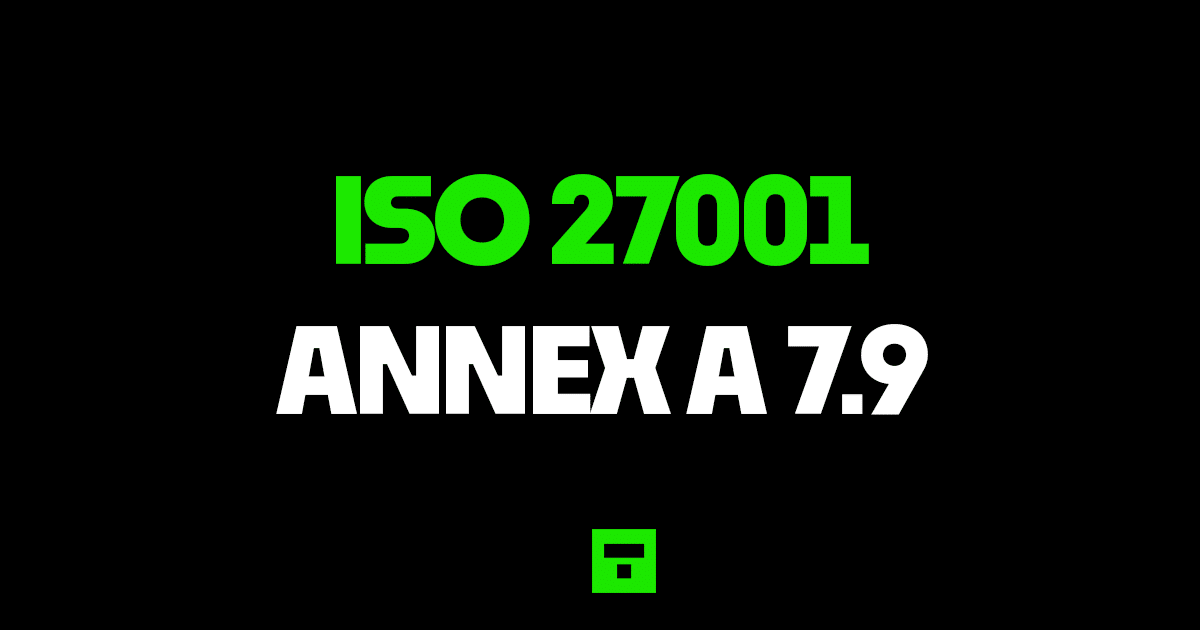Table of Contents
ISO 27001 Security of Assets Off-Premises
The focus for this ISO 27001 Control is your assets. As one of the ISO 27001 controls this is about the protection of those assets when not in an environment you control.
You will learn what the ISO 27001 control 7.9 is, how to simply and easily implement it for ISO 27001 certification and I will show you some common gotchas so you can avoid them.
What is ISO 27001 Annex A 7.9?
ISO 27001 Annex A 7.9 Security of assets off-premises is an ISO 27001 control that looks to protect equipment by siting it securely and protecting it.
Purpose
The purpose of Annex A 7.9 is to prevent loss, damage, theft or compromise of off-site devices and interruption to the organisations operations..
Definition
The ISO 27001 standard defines Annex A 7.9 as:
Off-site assets should be protected.
ISO 27001:2022 Annex A 7.9 Security of assets off-premises
DO IT YOURSELF ISO 27001
All the templates, tools, support and knowledge you need to do it yourself.
How to implement ISO 27001 Annex A 7.9
General Guidance
Well in this modern world people take their equipment of site. This used to be a massive thing a few years ago when everyone was chained to an office and all the equipment stayed at the office. Taking things off site was such a palaver, with forms and authorisation and massive forklift trucks to move those ‘laptops’. Things have moved on but the control remains now with a more general focus on the protection of assets off site. Rather than the process of authorising it.
Education and Training
Like much of the standard we are looking at common sense really when it comes to this control. There is a combination of telling people what is expected, training them, educating them and also where possible putting some technical controls in place if they help reduce risk.
Off Site Protection
We always want to protect what is important to us so in this situation we are looking at what are the threats that can be posed by having assets in an environment that we do not control and therefore what are things we can do to address those threats.
Public Areas
Simple things like not having assets left unattended in public areas. Seems to make sense but we have all seen people leave laptops open in bars, restaurants and on trains whilst they go and ‘use the facilities’.
Shoulder Surfing
There is a lot of shoulder surfing that goes on as well. People reading over your shoulder or between the gaps in train and aeroplane seats. We all like to be nosey, am I right? We can do things like be conscious of it and position ourselves so as not to facilitate it and we can consider the use of privacy screens and screen protectors. What ever works for you.
Related Controls
There are a couple of other controls worth reading up here as well being ISO 27001 Annex A 6.7 Remote Working and ISO 27001 Annex A 8.1 User End Point Devices.
ISO 27001 Templates
ISO 27001 templates have the advantage of being a massive boost that can save time and money so before we get into the implementation guide we consider these pre written templates that will sky rocket your implementation. Not interested in ISO 27001 templates, then you can skip to the next section.
How to comply with ISO 27001 Annex A 7.9
To comply with ISO 27001 Annex A 7.9 you are going to
- Train, educate, tell and communicate to people what is expected of them
- Assess you assets and perform a risk assessment
- Implement controls proportionate to the risk posed
- Test the controls that you have to make sure they are working
Top 3 Mistakes People Make for ISO 27001 Annex A 7.9
The top 3 mistakes people make for ISO 27001 Annex A 7.9 are
1. You haven’t told people what is expected
It is really hard to control assets when you don’t control the environment that they are in. You cannot account for every situation and variable but you can equip people with the knowledge to make the right choices and the tools to reduce the risks. If you don’t communicate and educate and inform then this control will fail.
2. One or more members of your team haven’t done what they should have done
Prior to the audit check that all members of the team have done what they should have. Do they know where the policies are? Have they acknowledged them? Have you checked a sample of off site workers and offsite workers to see if the controls are being followed? Check!
3. Your document and version control is wrong
Keeping your document version control up to date, making sure that version numbers match where used, having a review evidenced in the last 12 months, having documents that have no comments in are all good practices.
Get the Help of the ISO 27001 Ninja
Book your FREE 30 Minute ISO 27001 Strategy Call and let me show you how you can do it 30x cheaper and 10x faster that you ever thought possible.
ISO 27001 Controls and Attribute Values
| Control type | Information security properties | Cybersecurity concepts | Operational capabilities | Security domains |
|---|---|---|---|---|
| Preventive | Confidentiality | Protect | Physical Security | Protection |
| Integrity | Asset management | |||
| Availability |


